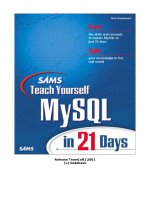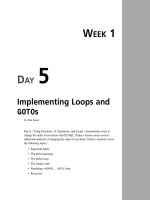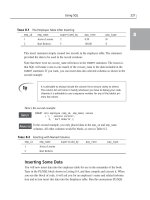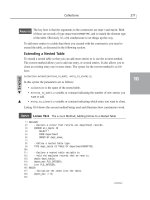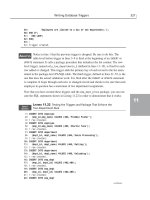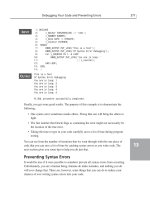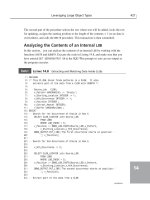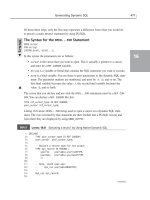Tài liệu Teach Yourself PL/SQL in 21 Days- P11 docx
Bạn đang xem bản rút gọn của tài liệu. Xem và tải ngay bản đầy đủ của tài liệu tại đây (2.7 MB, 50 trang )
Generating Dynamic SQL 477
16
Of those three steps, only the first step represents a difference from what you would do
to process a static
SELECT
statement by using PL/SQL.
The Syntax for the
OPEN...FOR
Statement
OPEN cursor
FOR string
[USING bind[, bind]...];
In this syntax the parameters are as follows:
•
cursor
is the cursor that you want to open. This is actually a pointer to a cursor,
and must be a
REF CURSOR
variable.
•
string
is a variable or literal that contains the SQL statement you want to execute.
•
bind
is a bind variable. You use these to pass parameters to the dynamic SQL state-
ment. The parameter markers are numbered, and must be
:1
,
:2
, and so on. The
first bind variable becomes the value
:1
,the second bind variable becomes the
value
:2
, and so forth.
The cursor that you declare and use with the
OPEN...FOR
statements must be a
REF CUR-
SOR
. You can declare a
REF CURSOR
like this:
TYPE ref_cursor_type IS REF CURSOR;
your_cursor ref_cursor_type;
Listing 16.8 shows
OPEN...FOR
being used to open a cursor on a dynamic SQL state-
ment. The rows returned by that statement are then fetched into a PL/SQL record, and
from there they are displayed by using
DBMS_OUTPUT
.
L
ISTING
16.8 Executing a
SELECT
by Using Native Dynamic SQL
1: DECLARE
2: TYPE your_cursor_type IS REF CURSOR;
3: your_cursor your_cursor_type;
4:
5: -- Declare a record type for the output
6: TYPE dyn_record IS RECORD (
7: yourrow yourtable.yourrow%TYPE,
8: yourdesc yourtable.yourdesc%TYPE
9: );
10:
11: -- Note, could also use:
12: -- dyn_rec yourtable%ROWTYPE;
13: --
14: dyn_rec dyn_record;
15:
,
S
YNTAX
,
I
NPUT
continues
22 7982 ch16 11/30/99 1:06 PM Page 477
Please purchase PDF Split-Merge on www.verypdf.com to remove this watermark.
16: dynamic_select_stmt VARCHAR2(100);
17: BEGIN
18: -- Generate the dynamic SELECT statement.
19: dynamic_select_stmt :=
20: ‘SELECT yourrow, yourdesc FROM yourtable’;
21: dynamic_select_stmt := dynamic_select_stmt ||
22: ‘ ORDER BY yourrow DESC’;
23:
24: -- Open a cursor on the dynamic statement.
25: OPEN your_cursor FOR dynamic_select_stmt;
26:
27: -- Loop through and display all the data.
28: LOOP
29: -- Fetch the next row, exit the loop when
30: -- no more data is left.
31: FETCH your_cursor
32: INTO dyn_rec;
33: EXIT WHEN your_cursor%NOTFOUND;
34:
35: -- Display the data using DBMS_OUTPUT
36: DBMS_OUTPUT.PUT_LINE(dyn_rec.yourrow ||
37: ‘ ‘ || dyn_rec.yourdesc);
38: END LOOP;
39:
40: -- Close the cursor.
41: CLOSE your_cursor;
42:
43: END;
44: /
5 Five
4 Four
3 Three
2 Two
1 One
PL/SQL procedure successfully completed.
The
REF CURSER
variable used with the
OPEN
statement is declared in lines 2–3.
Lines 18–20 build on the initial
SELECT
statement, and the next two lines (21–22)
add an
ORDER BY
clause. The cursor is opened in line 25, through the use of the
OPEN...FOR
statement. Note that
OPEN FOR
references the
VARCHAR2
variable containing
the
SELECT
statement. From here on out, it’s just normal everyday PL/SQL cursor pro-
cessing. The
FETCH
in lines 31–32 fetches the data from the cursor into a record. You
could also fetch the data into a list of variables. The
DBMS_OUTPUT
call in line 36–37
allow SQL*Plus to display the data, and the
CLOSE
statement in line 41 closes the cursor
after all the data has been processed.
478 Day 16
L
ISTING
16.8 continued
O
UTPUT
A
NALYSIS
22 7982 ch16 11/30/99 1:06 PM Page 478
Please purchase PDF Split-Merge on www.verypdf.com to remove this watermark.
Generating Dynamic SQL 479
16
Executing PL/SQL Blocks
You can execute PL/SQL blocks by using native dynamic SQL through the use of the
EXECUTE IMMEDIATE
statement. Listing 16.9 shows the native dynamic SQL version of
Listing 16.4.
L
ISTING
16.9 Executing a PL/SQL Block Using Native Dynamic SQL
1: DECLARE
2: block_to_execute VARCHAR2(200) :=
3: ‘BEGIN
4: SELECT YourRow,YourDesc
5: INTO :1, :2 FROM YourTable
6: WHERE YourRow = 2;
7: END;’;
8:
9: YourRow NUMBER;
10: YourDesc VARCHAR2(100);
11: BEGIN
12: EXECUTE IMMEDIATE block_to_execute
13: USING OUT YourRow, OUT YourDesc;
14:
15: DBMS_OUTPUT.PUT_LINE(YourRow || ‘ ‘ || YourDesc);
16: END;
17: /
You can see that this code is a lot simpler to understand than the Listing 16.4
version. The
block_to_execute
variable, declared in lines 2–7, contains the
PL/SQL block to be executed. The
EXECUTE IMMEDIATE
statement in lines 12–13 is used
to execute the block. The crucial thing to note here is that the bind variables listed in the
USING
clause both have the keyword
OUT
in front of them. This allows them to receive
values back from the PL/SQL block. So the PL/SQL block issues a
SELECT...INTO
state-
ment that places values into these variables, and because they are
OUT
bind variables,
those values are returned to you.
I
NPUT
A
NALYSIS
This code fails if there are two rows in
YOURTABLE
with a value of
2
for the
YOURROW
column. If you ran Listing 16.7 more than once, that might be the
case.
Caution
22 7982 ch16 11/30/99 1:06 PM Page 479
Please purchase PDF Split-Merge on www.verypdf.com to remove this watermark.
Summary
Today’s lesson covers Oracle’s
DBMS_SQL
package, as well as the new native dynamic
SQL features included with Oracle8i. Both let you dynamically build and execute SQL
statements from within PL/SQL.
DBMS_SQL
is the way to go if your code must run on
releases of Oracle prior to the 8i release. Otherwise, you should use native dynamic SQL
if you can. You’ll find it much easier to deal with, and the resulting code will be more
easily understood.
With
DBMS_SQL
, you have to open a cursor for each statement, define bind variables, fetch
rows returned by queries, and get each column one at a time. Quite a lot of code is need-
ed to do all that, and that code is rather tedious to write. Native Dynamic SQL simplifies
things. Using Native Dynamic SQL, as with
DBMS_SQL
, you open a cursor for a dynami-
cally generated SQL statement. However, unlike with
DBMS_SQL
, you can then treat that
cursor as an ordinary PL/SQL cursor. Fetching the data then becomes a very easy task.
Q&A
QNow that native dynamic SQL has arrived, is there any reason I would ever
use
DBMS_SQL
?
A There probably are some reasons, but there sure aren’t many. One thing that
DBMS_SQL
can handle that native dynamic SQL can’t, at least not easily, is the situa-
tion where you know absolutely nothing about the tables and columns that you will
be querying.
DBMS_SQL
allows you to issue a query, and then dynamically discover
how many columns the query returns, as well as what the datatypes are. That’s a
fairly advanced use, but if you need to be able to do it, then you need to use
DBMS_SQL
.
Q What three types of statements can be executed dynamically?
A Using dynamic SQL, you can execute non-query DDL and DML statements, SQL
queries, and anonymous PL/SQL blocks.
Q Should dynamically executed queries be written with trailing semicolons?
A No! This is a very common mistake to make. Do not include a trailing semicolon
with any dynamic SQL statement. The reason is that strictly speaking, the semi-
colon is not part of the SQL syntax. You need it when you write a static SQL state-
ment, because Oracle needs to know where the SQL statement ends. However,
when you are writing dynamic SQL, you are only working with one statement at a
time, so a terminator is not needed.
480 Day 16
22 7982 ch16 11/30/99 1:06 PM Page 480
Please purchase PDF Split-Merge on www.verypdf.com to remove this watermark.
Generating Dynamic SQL 481
16
Q What are the general steps for using
DBMS_SQL
?
A You need to open a cursor, parse the statements to be executed, bind any variables
that are necessary, define columns if you are executing a
SELECT
statement, execute
the query, retrieve the data (if there is any) into some PL/SQL variables, and close
the cursor.
Workshop
You can use this to test your comprehension of this lesson and put what you’ve learned
into practice. You’ll find the answers to the quiz and exercises in Appendix A,
“Answers.”
Quiz
1. For DML and DDL statements, and also for queries, what punctuation must not be
included at the end of the query?
2. What is meant by the term dynamic SQL?
3. What is Oracle’s term for the new version of dynamic SQL?
4. When using native dynamic SQL, what new form of the
OPEN
statement is used to
open a cursor on a dynamic SQL statement?
Exercise
Write a stored procedure to take a username as an argument, and create a version of
mytable
in that user’s schema.
22 7982 ch16 11/30/99 1:06 PM Page 481
Please purchase PDF Split-Merge on www.verypdf.com to remove this watermark.
22 7982 ch16 11/30/99 1:06 PM Page 482
Please purchase PDF Split-Merge on www.verypdf.com to remove this watermark.
D
AY
17
W
EEK
3
Writing to Files and the
Display
by Timothy Atwood and Jonathan Gennick
The PL/SQL language itself does not have any mechanism for performing
either file or screen output. However, Oracle supplies a number of built-in
packages that allow you to perform I/O, and that can be called from PL/SQL.
Today’s lesson talks about the following:
• The
DBMS_OUTPUT
package
• The
UTL_FILE
package
• The
TEXT_IO
package
You’ve already seen
DBMS_OUTPUT
used throughout this book as a way to dis-
play output on the screen, using SQL*Plus. It has some other capabilities, too,
which you’ll learn about today. The
UTL_FILE
and
TEXT_IO
packages allow you
to read and write text files.
UTL_FILE
is a server-side built-in package that
allows you to read and write files on the database server.
TEXT_IO
is an Oracle
Developer package that allows you to do file input/output (I/O) on the client.
23 7982 ch17 11/30/99 1:05 PM Page 483
Please purchase PDF Split-Merge on www.verypdf.com to remove this watermark.
Exploring the
DBMS_OUTPUT
Package
Looking at many of the examples in this book might lead you to believe that
DBMS_OUTPUT
’s only function is to allow you to display PL/SQL output using SQL*Plus.
That’s only part of the story, though.
DBMS_OUTPUT
is actually designed to let you write
output to a buffer in memory, and then read that output back again. Figure 17.1 illustrates
this, and also shows how SQL*Plus fits into the picture.
484 Day 17
F
IGURE
17.1
DBMS_OUTPUT
allows
you to read and write
data to and from a
buffer in memory.
PL/SQL Program Unit
PUT_LINE
Memory Buffer
GET_LINE
SQL*Plus
DBMS_OUTPUT
Package
From PL/SQL, you make
calls to
PUT_LINE
in order
to place text in the buffer
SQL*Plus reads
text from the buffer
by making calls to
GET_LINE
The usefulness of
DBMS_OUTPUT
becomes apparent when you realize that the procedure
that reads data from the buffer does not have to be the same procedure that wrote it there
in the first place. Any procedure can read the data. When you issue the command
SET
SERVEROUTPUT ON
in SQL*Plus, you are really telling SQL*Plus to check the buffer for
data after each statement executes, fetch any data that’s found, and display it for you to
see. In its most generic sense,
DBMS_OUTPUT
can be used to communicate data between
any two PL/SQL procedures.
DBMS_OUTPUT
allows you to communicate between two program units that
are part of the same session. To communicate across sessions, you need to
use the
DBMS_PIPE
package. You’ll learn about that on Day 19, “Alerting and
Communicating with Other Procedures: The
DBMS_ALERT
and
DBMS_PIPE
Packages.”
Note
Enabling the
DBMS_OUTPUT
Package
Before you can use
DBMS_OUTPUT
, you need to call the initialization procedure
DBMS_OUTPUT.ENABLE
. SQL*Plus does this for you automatically whenever you issue a
SET SERVEROUTPUT ON
command. However, you might want to do it yourself. The main
reason that you might want to call
DBMS_OUTPUT.ENABLE
yourself is to allocate a buffer
23 7982 ch17 11/30/99 1:05 PM Page 484
Please purchase PDF Split-Merge on www.verypdf.com to remove this watermark.
Writing to Files and the Display 485
17
larger than the default of 20,000 characters. Another reason to call
DBMS_OUTPUT.ENABLE
yourself would be if SQL*Plus isn’t the destination for your messages.
The Syntax for the
DBMS_OUTPUT.ENABLE
Procedure
DBMS_OUTPUT.ENABLE (buffer_size IN INTEGER DEFAULT 20000);
The
buffer_size
parameter controls the size of the buffer, and can be any value between
2,000 and 1,000,000. The default is 20,000.
The following PL/SQL block shows a call to enable the
DBMS_OUTPUT
package:
BEGIN
DBMS_OUTPUT.ENABLE (1000000);
END;
If you are using
DBMS_OUTPUT
to send a lot of data to SQL*Plus, keep in mind that
SQL*Plus can’t begin reading until all the data is sent. Therefore, your buffer must be
large enough to contain all the output. Also bear in mind that SQL*Plus release 8.0 and
above allows you to specify the buffer size as an argument to the
SET SERVEROUTPUT ON
command. For example, the following command also enables
DBMS_OUTPUT
, and with a
buffer size of 1,000,000 bytes:
SET SERVEROUTPUT ON SIZE 1000000
After you enable the package, you can use it to write data to the buffer, and to read it
back again.
Disabling the
DBMS_OUTPUT
Package
When you’re done using
DBMS_OUPUT
, you can disable the package by making a call to
DBMS_OUTPUT.DISABLE
. This has the effect of purging the buffer of any remaining infor-
mation.
The Syntax for the
DBMS_OUTPUT.DISABLE
Procedure
DBMS_OUTPUT.DISABLE;
There are no parameters to the
DISABLE
procedure. The following PL/SQL block shows
how it is called:
BEGIN
DBMS_OUTPUT.DISABLE;
END;
SQL*Plus calls
DBMS_OUTPUT.DISABLE
for you whenever you issue a
SET SERVEROUTPUT
OFF
command. After output has been disabled, any further calls to
DBMS_OUTPUT.PUT_LINE
,
DBMS_OUTPUT.GET_LINE
, and so forth are ignored.
S
YNTAX
S
YNTAX
23 7982 ch17 11/30/99 1:05 PM Page 485
Please purchase PDF Split-Merge on www.verypdf.com to remove this watermark.
Writing Data to the Buffer
Youwrite data to the
DBMS_OUTPUT
buffer by using a combination of the
PUT_LINE
,
PUT
,
and
NEW_LINE
procedures.
PUT_LINE
writes a line of text, followed by a newline charac-
ter.
PUT
writes text, but doesn’t follow that text with a newline. The
NEW_LINE
procedure
writes one newline character.
The Syntax for the
DBMS_OUTPUT.PUT_LINE
,
DBMS_OUTPUT.PUT
, and
DBMS_OUTPUT.NEW_LINE
Procedures
DBMS_OUTPUT.PUT_LINE (item IN NUMBER);
DBMS_OUTPUT.PUT_LINE (item IN VARCHAR2);
DBMS_OUTPUT.PUT_LINE (item IN DATE);
DBMS_OUTPUT.PUT (item IN NUMBER);
DBMS_OUTPUT.PUT (item IN VARCHAR2);
DBMS_OUTPUT.PUT (item IN DATE);
DBMS_OUTPUT.NEW_LINE;
In this syntax
item
is the value written to the buffer. Items of type
DATE
and
NUMBER
are
always converted to text before being written.
The
PUT
and
PUT_LINE
procedures each take one argument. The procedures are over-
loaded in order to allow you to pass in dates, numbers, and text. If you pass in text, it is
written to the buffer. If you pass in a date or a number, it is converted to text, and then
written to the buffer. It’s usually best to convert things to text yourself, so that you can
control the output format.
The following example, in Listing 17.1, shows
DBMS_OUTPUT
being enabled, and some
data being written to the buffer. SQL*Plus has been used to execute the block and cap-
ture the output.
L
ISTING
17.1
Using
DBMS_OUTPUT
to Place Data in the Buffer
1: SET SERVEROUTPUT ON
2:
3: BEGIN
4: --We only need a small buffer for this example.
5: DBMS_OUTPUT.ENABLE (2000);
6:
7: DBMS_OUTPUT.PUT_LINE(‘Three names will be written.’);
8: DBMS_OUTPUT.PUT(‘Jenny’);
9: DBMS_OUTPUT.NEW_LINE;
10: DBMS_OUTPUT.PUT(‘Shirley’);
11: DBMS_OUTPUT.NEW_LINE;
12: DBMS_OUTPUT.PUT(‘Tina’);
486 Day 17
,
S
YNTAX
,
I
NPUT
23 7982 ch17 11/30/99 1:05 PM Page 486
Please purchase PDF Split-Merge on www.verypdf.com to remove this watermark.
Writing to Files and the Display 487
17
13: DBMS_OUTPUT.NEW_LINE;
14: END;
15: /
Three names will be written.
Jenny
Shirley
Tina
PL/SQL procedure successfully completed.
This PL/SQL block writes one line into the buffer by using the
PUT_LINE
proce-
dure (line 5). It then writes three more lines using a combination of the
PUT
and
NEW_LINE
procedures (lines 6–11). Because
SERVEROUTPUT
had been turned on,
SQL*Plus reads the data from the buffer and displays it onscreen.
The
PUT
and
PUT_LINE
procedures only handle lines up to 255 characters long. If you
attempt to write a line longer than that, you get an error. You also get an error if you
attempt to write more data into the buffer than it will hold.
Reading Data from the Buffer
Two procedures,
GET_LINE
and
GET_LINES
,allow you to read from the buffer.
GET_LINE
allows you to read one line at a time, and
GET_LINES
allows you to read several lines into
an array.
The Syntax for
GET_LINE
and
GET_LINES
DBMS_OUTPUT.GET_LINE (
line OUT VARCHAR2,
status OUT INTEGER);
DBMS_OUTPUT.GET_LINES (
lines OUT CHARARR,
numlines IN OUT INTEGER);
In this syntax the parameters are as follows:
•
line
is the line retrieved by
GET_LINE
.
•
status
indicates whether a line was retrieved. A status of
1
means that the line
parameter contains a line retrieved from the buffer. A status of
0
means that the
buffer was empty[md]that is, nothing was retrieved.
•
lines
is a table of
VARCHAR2(255)
. You can declare this table by using the type
DBMS_OUTPUT.CHARARR
. See Listing 17.2 for an example.
•
numlines
is both an input and an output. When calling
GET_LINES
, you should set
this to the number of lines that you want to retrieve.
GET_LINES
replaces that value
with the number of lines that were actually retrieved.
O
UTPUT
A
NALYSIS
,
S
YNTAX
,
23 7982 ch17 11/30/99 1:05 PM Page 487
Please purchase PDF Split-Merge on www.verypdf.com to remove this watermark.
The example in Listing 17.2 is an extension of Listing 17.1. It shows
GET_LINE
being
used to retrieve the three names from the buffer. It also demonstrates that the buffer con-
tents are maintained across PL/SQL blocks.
488 Day 17
This listing should be executed from SQL*Plus.
Note
L
ISTING
17.2
Using
GET_LINE
to Retrieve Data From the Buffer
1: SET SERVEROUTPUT OFF
2:
3: BEGIN
4: --We only need a small buffer for this example.
5: DBMS_OUTPUT.ENABLE (2000);
6:
7: DBMS_OUTPUT.PUT_LINE(‘Three names will be written.’);
8: DBMS_OUTPUT.PUT(‘Jenny’);
9: DBMS_OUTPUT.NEW_LINE;
10: DBMS_OUTPUT.PUT(‘Shirley’);
11: DBMS_OUTPUT.NEW_LINE;
12: DBMS_OUTPUT.PUT(‘Tina’);
13: DBMS_OUTPUT.NEW_LINE;
14: END;
15: /
16:
17: PL/SQL procedure successfully completed.
18:
19:
20: SET SERVEROUTPUT ON
21: DECLARE
22: throw_away VARCHAR2(50);
23: name1 VARCHAR2(10);
24: name2 VARCHAR2(10);
25: name3 VARCHAR2(10);
26: status NUMBER;
27: BEGIN
28: --The first line in the buffer is a throw away.
29: DBMS_OUTPUT.GET_LINE(throw_away, status);
30:
31: --The next three lines will be the three names.
32: DBMS_OUTPUT.GET_LINE(name1, status);
33: DBMS_OUTPUT.GET_LINE(name2, status);
34: DBMS_OUTPUT.GET_LINE(name3, status);
35:
36: --Now that we have the names, write them out
37: --on one line. SQL*Plus will pick this up and
38: --display it.
39: DBMS_OUTPUT.PUT_LINE(name1 || ‘ and ‘ ||
40: name2 || ‘ and ‘ || name3);
I
NPUT
/
O
UTPUT
23 7982 ch17 11/30/99 1:05 PM Page 488
Please purchase PDF Split-Merge on www.verypdf.com to remove this watermark.
Writing to Files and the Display 489
17
41: END;
42: /
Jenny and Shirley and Tina
PL/SQL procedure successfully completed.
The first PL/SQL block (lines 3–14) writes three names into the buffer, one name
to a line. Because this example is executed from SQL*Plus, the
SERVEROUTPUT
setting is turned off (line 1) to prevent SQL*Plus from reading and displaying the names.
Instead, the names remain in the buffer, where they can be accessed by the second block.
The second PL/SQL block (lines 21–41) reads the first line and throws it away (line
28–29). Then it reads each of the three names (lines 32–34). Finally, it concatenates
those three names together in one line, and writes that line back out to the buffer (lines
36–40). Because the
SERVEROUTPUT
setting has been turned on for the second block,
SQL*Plus reads the results and displays them onscreen.
A
NALYSIS
The buffer is a first-in, first-out (FIFO) buffer. The first line to be written is
also the first to be read.
Note
If you need to retrieve several lines at once from the buffer, you can use the
GET_LINES
procedure. It accepts a PL/SQL table (the equivalent of an array) as an argument, and
retrieves as many lines as you request into that array. By modifying the code shown in
Listing 17.2 to use
GET_LINES
instead of
GET_LINE
, you can retrieve all three names by
using only one procedure call, as shown in Listing 17.3.
L
ISTING
17.3
Using
GET_LINES
to Retrieve Three Lines from the Buffer with
One Procedure Call
1: SET SERVEROUTPUT OFF
2:
3: BEGIN
4: --We only need a small buffer for this example.
5: DBMS_OUTPUT.ENABLE (2000);
6:
7: DBMS_OUTPUT.PUT_LINE(‘Three names will be written.’);
8: DBMS_OUTPUT.PUT(‘Jenny’);
9: DBMS_OUTPUT.NEW_LINE;
10: DBMS_OUTPUT.PUT(‘Shirley’);
11: DBMS_OUTPUT.NEW_LINE;
12: DBMS_OUTPUT.PUT(‘Tina’);
I
NPUT
/
O
UTPUT
continues
23 7982 ch17 11/30/99 1:05 PM Page 489
Please purchase PDF Split-Merge on www.verypdf.com to remove this watermark.
13: DBMS_OUTPUT.NEW_LINE;
14: END;
15: /
16:
17: PL/SQL procedure successfully completed.
18:
19:
20: SET SERVEROUTPUT ON
21: DECLARE
22: throw_away VARCHAR2(50);
23: names DBMS_OUTPUT.CHARARR;
24: lines_to_get NUMBER;
25: inx1 NUMBER;
26: combined_names VARCHAR2(80);
27: status NUMBER;
28: BEGIN
29: --The first line in the buffer is a throw away.
30: DBMS_OUTPUT.GET_LINE(throw_away, status);
31:
32: --The next three lines will be the three names.
33: lines_to_get := 3;
34: DBMS_OUTPUT.GET_LINES(names, lines_to_get);
35:
36: --Now that we have the names, write them out
37: --on one line. SQL*Plus will pick this up and
38: --display it.
39: combined_names := ‘’;
40: FOR inx1 IN 1 .. lines_to_get LOOP
41: IF inx1 > 1 THEN
42: combined_names := combined_names || ‘ and ‘;
43: END IF;
44:
45: combined_names := combined_names || names(inx1);
46: END LOOP;
47: DBMS_OUTPUT.PUT_LINE(combined_names);
48: END;
49: /
Jenny and Shirley and Tina
PL/SQL procedure successfully completed.
The use of
GET_LINES
actually makes this version of the code more complex.
Line 23, in the second block, is where the table of type
DBMS_OUTPUT.CHARARR
is
declared. That table is eventually used to hold the results. Lines 29–30 are the same as in
Listing 17.2, and simply serve to throw away the first line in the buffer. The call to
490 Day 17
L
ISTING
17.3
continued
A
NALYSIS
23 7982 ch17 11/30/99 1:05 PM Page 490
Please purchase PDF Split-Merge on www.verypdf.com to remove this watermark.
Writing to Files and the Display 491
17
GET_LINES
occurs in lines 32–34. The
lines_to_get
parameter contains the value
3
,
telling
GET_LINES
to return all three names. The loop in line 40–43 then uses the value
that
GET_LINES
passes back to iterate through the array the proper number of times. If
GET_LINES
returned more than three lines, or fewer than three lines, the value of
lines_to_get
would be set appropriately, and the loop would concatenate all the lines
together.
Exceptions Raised from the
DBMS_OUTPUT
Package
There are two exceptions you have to worry about when using the
DBMS_OUTPUT
package.
These are described in Table 17.1, along with the actions required to fix the problems.
T
ABLE
17.1
Exceptions Raised by
DBMS_OUTPUT
Exception Code Error Description Corrective Action
ORU-10027
Buffer overflow Increase the buffer size if possible.
Otherwise, find a way to write less data.
ORU-10028
Line length Make sure that all calls made to
PUT
and
overflow, limit of
PUT_LINE
have fewer than 255 characters.
255 characters per line
Now that you know the exceptions, you can trap errors as they occur.
Reading and Writing Files with the
UTL_FILE
Package
The
UTL_FILE
package enables you to read and write files on the database server. There
are two prerequisites to using
UTL_FILE
:
•You must be granted execute privileges on the
UTL_FILE
package.
•Your database administrator must set a database initialization parameter named
UTL_FILE_DIR
.
Granting access to the package is easy. If you don’t already have execute privileges on
UTL_FILE
, your database administrator can grant it by logging on as the user
SYS
, and
issuing a command like this:
GRANT EXECUTE ON utl_file TO username;
I
NPUT
23 7982 ch17 11/30/99 1:05 PM Page 491
Please purchase PDF Split-Merge on www.verypdf.com to remove this watermark.
The matter of the
UTL_FILE_DIR
parameter is a bit more difficult to explain. You can’t
just read and write files in any directory on the server. When you make calls to
UTL_FILE_DIR
,Oracle is really reading and writing the files for you. On most systems,
the Oracle software runs in privileged mode, giving it access to all the files. Needless to
say, that presents a security risk. To mitigate that risk, before
UTL_FILE
can be used, your
database administrator must set the
UTL_FILE_DIR
parameter to point to a specific list of
directories. All file I/O done by
UTL_FILE
must be done in one of those directories. The
examples in this book assume the following setting:
UTL_FILE_DIR = c:\a
If you’re experimenting with
UTL_FILE
on a workstation, you need to add this line to the
database parameter file. You also need to stop and restart the database afterward, in order
for the new setting to take effect.
When
UTL_FILE_DIR
is set, and you have been granted
EXECUTE
access to the
UTL_FILE
package, you are ready to read and write files.
File Input
Using
UTL_FILE
,the overall process to read (or write) a file is as follows:
1. Declare a file handle variable to use in identifying the file when you make calls to
the various
UTL_FILE
routines. You can use the type
UTL_FILE.FILE_TYPE
for this
purpose.
2. Declare a string of type
VARCHAR2
to act as a buffer for reading in the file one line
at a time.
3. Make a call to
UTL_FILE.FOPEN
to open the file. When you open a file, you need to
specify whether you want to read the file or write to the file. You can’t do both.
4. If you’re reading the file, make calls to
UTL_FILE.GET_LINE
. If you’re writing,
make calls to
UTL_FILE.PUT_LINE
.
5. When you’re done, call
UTL_FILE.FCLOSE
to close the file.
The next section talks briefly about the various
UTL_FILE
procedures and functions, and
shows the syntax information for each. Following that is a section with an example
showing
UTL_FILE
being used to write data to a file.
492 Day 17
23 7982 ch17 11/30/99 1:05 PM Page 492
Please purchase PDF Split-Merge on www.verypdf.com to remove this watermark.
Writing to Files and the Display 493
17
Using
UTL_FILE
Procedures and Functions
The
UTL_FILE
package implements the following procedures and functions:
Procedure
or Function Description
FCLOSE
Closes a file.
FCLOSE_ALL
Closes all the files.
FFLUSH
Flushes any buffered data to be written out to disk
immediately.
FOPEN
Opens a file.
GET_LINE
Reads one line from a file.
IS_OPEN
Checks whether a file is open.
NEW_LINE
Writes a newline character out to a file.
PUT
Writes a string of characters to a file, but doesn’t
follow that with a newline.
PUT_LINE
Writes one line to a file.
PUTF
Formats and writes output. This is a crude imita-
tion of C’s
printf()
procedure.
Many of the procedure names in the
UTL_FILE
package are named identically to corre-
sponding procedures in
DBMS_OUTPUT
. For example,
GET_LINE
and
PUT_LINE
are used in
both packages to read and write lines. The difference is in whether that I/O is done to
and from a file or to and from a memory buffer.
The
FCLOSE
Procedure
The
FCLOSE
procedure closes a file. If the buffer for the file being closed is not empty, it
is flushed to disk before the file is closed.
The Syntax for the
FCLOSE
Procedure
PROCEDURE FCLOSE(file IN OUT file_type);
The
file
parameter is the file handle returned from
FOPEN
when the file was originally
opened. Table 17.2 shows a list of possible exceptions raised by
FCLOSE
.
S
YNTAX
23 7982 ch17 11/30/99 1:05 PM Page 493
Please purchase PDF Split-Merge on www.verypdf.com to remove this watermark.
T
ABLE
17.2
Exceptions Raised by
FCLOSE
and
FCLOSE_ALL
Exception Raised Description of Error
UTL_FILE.INVALID_FILEHANDLE
You passed a file handle that didn’t represent an open file.
UTL_FILE.WRITE_ERROR
The operating system was unable to write to the file.
UTL_FILE.INTERNAL_ERROR
An internal error occurred.
The first exception in the list, that of an invalid file handle, is one that you can easily pre-
vent simply by being careful to write good code. Make sure you open a file before you
use it, and that you keep track of which variable has the file handle in it. Write errors can
occur if the disk is full, or if some other error prevents Oracle from writing the data for
you. An internal error indicates that Oracle itself is messed up.
The
FCLOSE_ALL
Procedure
The
FCLOSE_ALL
procedure closes all the files at once, flushing any buffers that are not
empty.
The Syntax for the
FCLOSE_ALL
Procedure
PROCEDURE FCLOSEALL;
Refer to Table 17.2 for a list of possible exceptions raised by
FCLOSE_ALL
. You should be
aware that although
FCLOSE_ALL
does close all files, it does not mark the files as closed.
Future calls to
IS_OPEN
still indicate that they are open, even though in reality they are
not.
The
FOPEN
Procedure
FOPEN
opens a file for reading, or for writing.
FOPEN
is a function, and it returns a file
handle pointing to the file that was opened. There are two versions of
FOPEN
. One allows
you to specify a maximum line size, and the other does not.
The Syntax for the
FOPEN
Procedure
FUNCTION FOPEN(location IN VARCHAR2,
filename IN VARCHAR2,
openmode IN VARCHAR2)
RETURN FILE_TYPE;
FUNCTION FOPEN(location IN VARCHAR2,
filename IN VARCHAR2,
openmode IN VARCHAR2,
max_linesize IN BINARY_INTEGER)
RETURN FILE_TYPE;
494 Day 17
S
YNTAX
,
S
YNTAX
,
23 7982 ch17 11/30/99 1:05 PM Page 494
Please purchase PDF Split-Merge on www.verypdf.com to remove this watermark.
Writing to Files and the Display 495
17
The parameters are as follows:
•
location
is the name of the directory containing the file. This must match one of
the directories listed for the
UTL_FILE_DIR
parameter.
•
filename
is the name of the file. The name can include an extension.
•
openmode
is the mode in which you are opening the file. Valid values are
R
,
W
, and
A
. Use
R
to read a file,
W
to write to a file, and
A
to append to an existing file.
•
max_linesize
allows you to specify the maximum line size. The allowed range is
1 through 32,767. If you omit this parameter, then the default, 1023, is used.
,
The ability to specify a line size in the
FOPEN
call is a new feature in Oracle8i.
With releases of Oracle prior to 8.1.5, you are limited to a line size of 1023
bytes or less.
If you open a file for write, and a file with the same name exists already,
that file is overwritten. If you append to a file that does not exist, a new file
is created.
Note
After the file has been successfully opened, the
FOPEN
function returns a file handle. You
must use that handle for all further operations on the file.
FOPEN
can raise several excep-
tions, which are listed in Table 17.3.
T
ABLE
17.3
Exceptions Raised by
FOPEN
Exception Raised Description of Error
UTL_FILE.INVALID_PATH
The directory is not valid. You should check it against
UTL_FILE_DIR
.
UTL_FILE.INVALID_MODE
An invalid mode was specified. The open mode must be
either
R
,
W
, or
A
.
UTL_FILE.INVALID_OPERATION
The file could not be opened for some other reason.
Verify that the Oracle software owner has access to the
directory (it could be a permissions issue) and contact
your database administrator for help.
UTL_FILE.INTERNAL_ERROR
An internal error occurred.
If you get the invalid path exception, you need to check your directory path against your
database’s
UTL_FILE_DIR
parameter setting. Remember, you can only write to the specif-
ic directories listed for that parameter. The invalid mode exception implies a coding
error. To correct it, just modify your code to use one of the valid modes. If you get an
,
23 7982 ch17 11/30/99 1:05 PM Page 495
Please purchase PDF Split-Merge on www.verypdf.com to remove this watermark.
invalid operation error, then there is some sort of operating system related reason why
you can’t open the file. Unfortunately, PL/SQL won’t give you any details about what
that problem is. The internal error is something you should never get, and indicates that
Oracle is not functioning properly.
The
GET_LINE
Function
When performing file input, in order to read data from the file into the buffer, you use
the
GET_LINE
function.
The Syntax for the
GET_LINE
Function
PROCEDURE GET_LINE(file IN FILE_TYPE,
buffer OUT VARCHAR2);
The parameters are as follows:
•
file
is the file handle returned from the FOPEN function when the file was origi-
nally opened.
•
buffer
is where the data is placed after it is read from the file. This must be of
type
VARCHAR2
. Possible errors that could arise are shown in Table 17.4.
T
ABLE
17.4
Exceptions Raised by
GET_LINE
Exception Raised Description of Error
UTL_FILE.INVALID_FILEHANDLE
You passed an invalid file handle. Possibly you forgot to
open the file first.
UTL_FILE.INVALID_OPERATION
The file is not open for reading (R mode), or there are
problems with file permissions.
UTL_FILE.VALUE_ERROR
The buffer is not long enough to hold the line being read
from the file. Increase the size of the buffer.
UTL_FILE.NO_DATA_FOUND
The end of file has been reached.
UTL_FILE.INTERNAL_ERROR
An error internal to the
UTL_FILE
system occurred.
UTL_FILE.READ_ERROR
An operating system error occurred while reading from
the file.
When you use
GET_LINE
to read a file, the maximum line length that it can handle is the
one specified when you opened the file. This defaults to 1023 bytes, not including the
newline character. The newline characters are stripped out, and aren’t returned to you.
The
IS_OPEN
Function
The
IS_OPEN
function tests to see if a file is open. You can use it before you attempt to
open a file to be sure that it’s not already open. You can also test to make sure a file is
open before you attempt to close it.
496 Day 17
,
S
YNTAX
,
23 7982 ch17 11/30/99 1:05 PM Page 496
Please purchase PDF Split-Merge on www.verypdf.com to remove this watermark.

